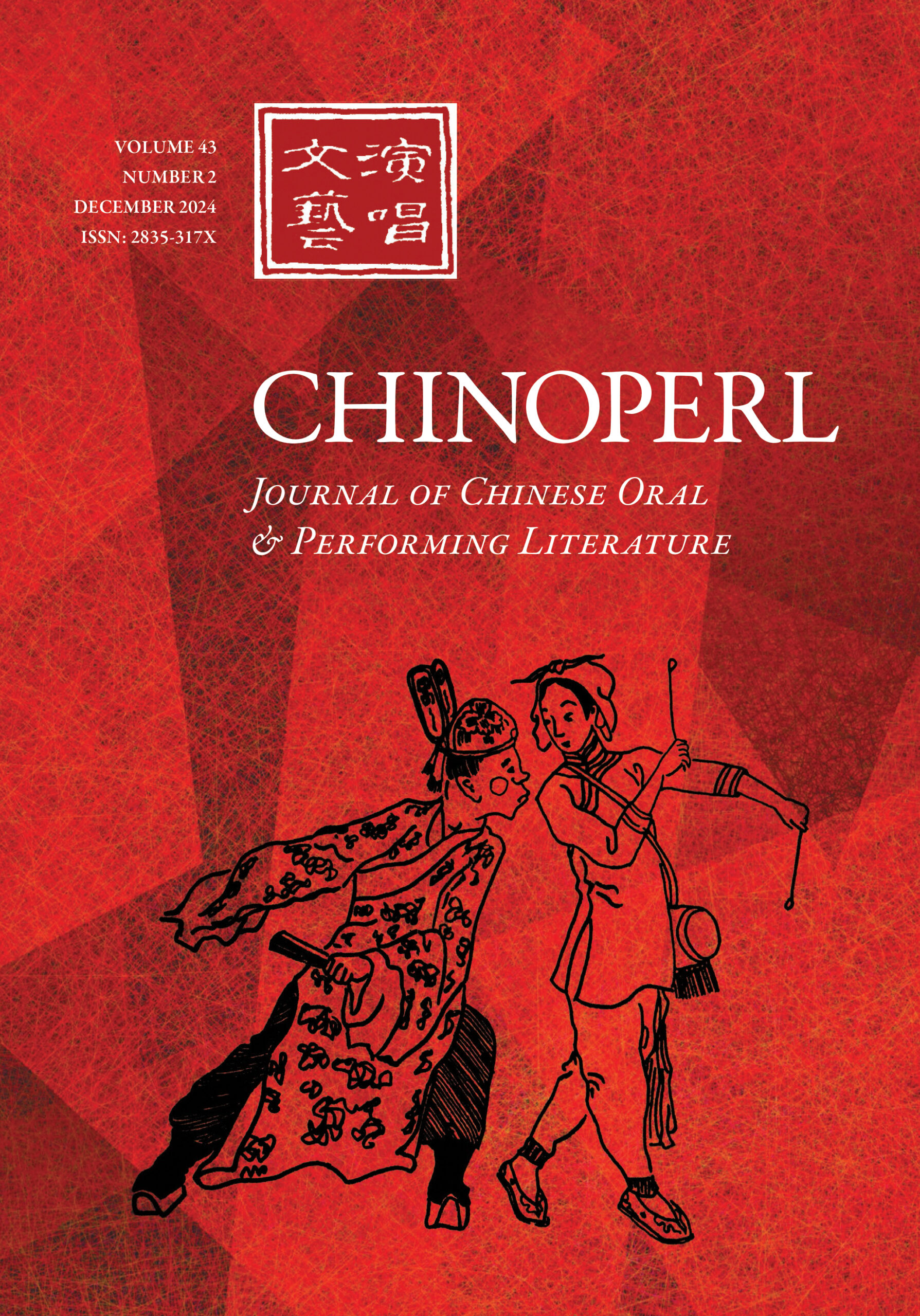CHINOPERL: Journal of Chinese Oral and Performing Literature
Individual Subscriptions
Institutional Subscriptions
Additional Information
CHINOPERL: Journal of Chinese Oral and Performing Literature (formerly, CHINOPERL Papers) is published by CHINOPERL, short for the Permanent Conference on Chinese Oral and Performing Literature.
The focus of CHINOPERL is on literature connected to oral performance, broadly defined as any form of verse or prose that has elements of oral transmission or performance either formally on stage or informally as a means of everyday communication. Such “literature” includes widely-accepted genres such as the novel, short story, drama, and poetry, but may also include proverbs, folksongs, and other traditional forms of linguistic expression.
Formerly CHINOPERL Papers, number 6 (1976) through number 31 (2012); CHINOPERL News, number 1 (1969) through number 5 (1975).
Individual access to the journal is only through society membership. This option includes both print and online subscriptions to the journal. Shipping charges applicable to international addresses. An online-only option is available to forgo shipping charges.
- Recent Articles
-
Introduction: Special Issue on Soundscapes of Twentieth-Century China
Posted on Tuesday December 16, 2025That Clarion Call: The Sounds and Meanings of Night Watchmen in China, ca. 1900–1940
Posted on Tuesday December 16, 2025The Stage Moves on Air: The Mediatization of Quyi in Early Twentieth-Century North China
Posted on Tuesday December 16, 2025Revolutionary Resonance: "The East Is Red" from Rural Shaanxi to China's First Satellite
Posted on Tuesday December 16, 2025Dueling and Converging Soundscapes in China and Korea
Posted on Tuesday December 16, 2025Muyu shu Collections in Libraries and Museums in the United States
Posted on Tuesday December 16, 2025In Memory of Susan Blader (1943–2025)
Posted on Tuesday December 16, 2025 - Pricing Guide
-
PAYMENT
All prices are indicated in U.S. dollars. Canadian customers must include 5% GST (automatically included at checkout). All prices shown are exclusive of any taxes.
Payment must be included with all orders. We accept payment by U.S. dollar checks drawn on a U.S. bank and made payable to the University of Hawaii Press. We also accept payment by Visa or MasterCard. If paying by credit card please include the card number, expiration date, cardholder name and billing address. If you wish to pay by bank transfer, please contact us for bank details. No refunds will be made except for erroneous duplicate orders.
PRINT SUBSCRIPTIONS – GENERAL INFORMATION
Subscription Start
Print subscriptions start from the first issue of the calendar year and are effective for the entire volume year. Subscriptions may be entered retroactively. Unless otherwise requested, subscriptions will start with the current year’s volume.
Shipping / Postage
All prices shown include standard delivery in the U.S.A. Additional postage will be charged at checkout for print orders mailed outside the U.S.A. Priority Mail option at additional cost is available at checkout. Please contact customer service for other shipping options.
Single Issues / Back Issues
Single-issues of current print volumes may be ordered. Print issues older than two years are available in limited supply and may be purchased at a discounted rate. Please fill out a single-issue order form.
Bookstores/Classroom Use
Bulk-rate discounts for one-time print orders are 20% on 10-19 copies and 30% on 20 or more copies. Postage charges are NOT discountable. All sales are final, we do not accept return of journal issues. Please contact customer service to order bulk copies.
INDIVIDUAL ORDER INFORMATION
Individual rates apply to subscriptions and single issue orders for individual (personal) use. You must provide a first name, last name, and telephone number.
Online access
When you place your order for online access (electronic subscription), you will receive an emailed receipt that includes an activation code and a link to this page: https://associations.press.jhu.edu/uhp/
Please enter your activation code and register on the site to gain access to the journal content.
A FAQ is available here: https://faq.press.jhu.edu/uhp
We are pleased to partner with the Johns Hopkins University Press and Project MUSE to provide online access to subscribers.
INSTITUTIONAL ORDER INFORMATION
Institutional rates apply to subscriptions and single issue orders for Institutional / Organizational use and paid for by libraries, universities, schools, societies, government offices, departments, businesses and the like. If you are ordering on behalf of your institution, please include the institution name.
Online access and Print + Online orders
Institutions may order electronic subscriptions or print + electronic through our hosting partner Project MUSE: http://muse.jhu.edu/about/order/single_title_options.html
You may contact Project MUSE at [email protected].
SUBSCRIPTION CLAIMS
Claims for non-receipt of issues will be honored at no charge within 180 days of the original ship date. Thereafter, the single copy rate will be charged for replacement. No more than one free replacement per issue will be allowed. Credits for non-receipt are not offered.
SUBSCRIPTION AGENTS
Please see our current title listing and rate sheet. We offer an agency discount of 5% off the institutional subscription rate. We do not offer discounts on single issue orders or postage. New agents must provide the URL of their business website or submit their initial correspondence on official company letterhead.
Please contact customer service at:
Journals Department, University of Hawai‘i Press, 2840 Kolowalu Street, Honolulu, HI 96822
Tel. 1-808-956-8833; Fax 1-808-988-6052
Toll-free (U.S. & Canada) Tel. 1-888-UHPRESS; Fax 1-800-650-7811
e-mail: [email protected]
- Author Guidelines
- Editorial Board
-
Editor
Jing Shen, Eckerd College, USA
Consulting Editor
David Rolston, University of Michigan, USA
Associate Editors
Catherine C. Swatek, University of British Columbia, Canada
Vibeke Børdahl, Nordic Institute of Asian Studies, Denmark
Margaret Wan, University of Utah, USA
Editorial Board
Mark Bender, The Ohio State University, USA
Susan Blader, Dartmouth College, USA
Claire Conceison, Duke University, USA
Andrea Goldman, University of California, Los Angeles, USA
GUO Yingde, Beijing Normal University, China
HAI Zhen, National Academy of Theatre Arts, Beijing, China
Robert E Hegel, Washington University, St Louis, USA
Hua Wei, The Chinese University of Hong Kong, Hong Kong
Wilt L Idema, Harvard University, USA
David Johnson, University of California, Berkeley, USA
Rainier Lanselle, École Pratique des Hautes Études, France
Kathryn Lowry, The Hong Kong Polytechnic University, Hong Kong
Colin Mackerras, Griffith University, Australia
Victor H. Mair, University of Pennsylvania, USA
Lindy Li Mark, California State University, East Bay, USA
Anne E. McLaren, University of Melbourne, Australia
Helen Rees, University of California, Los Angeles, USA
Sue M. C. Tuohy, Indiana University, USA
C.K. Wang, National Tsing-Hua University, Taiwan
Elizabeth Wichmann-Walzcak, University of Hawai‘i at Mānoa, USA
Bell Yung, University of Pittsburgh, USA
Judith T. Zeitlin, University of Chicago, USA
- Indexes
-
Articles appearing in CHINOPERL: Journal of Chinese Oral and Performing Literature are indexed and/or abstracted in:
Association for Asian Studies-
Bibliography of Asian Studies (Online)Elsevier BV-
ScopusModern Language Association-
MLA International BibliographyProQuest-
RILM Abstracts of Music Literature (Repertoire International de Litterature Musicale)






